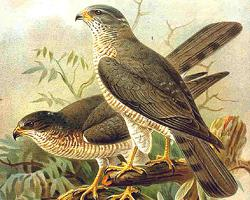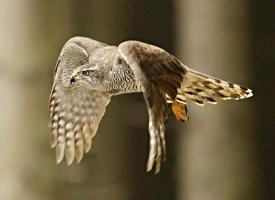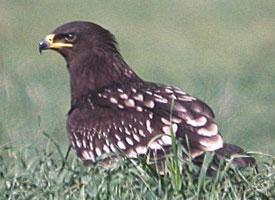
Statut de conservation
| Menacé |
Description de l'animal
The Levant sparrowhawk (Accipiter brevipes) is a small yet fascinating bird of prey that belongs to the family Accipitridae, which encompasses hawks, eagles, and kites, among others. This species exhibits a blend of agility and elegance, traits that are characteristic of the genus Accipiter, known for their adept hunting skills and remarkable adaptability.Characteristically, the Levant sparrowhawk is a medium-sized bird, with adult males typically reaching about 29 to 34 cm in length, whereas females are larger, measuring approximately 35 to 38 cm. This size difference between genders, known as sexual dimorphism, is quite common in raptors and is particularly pronounced in this species. The wingspan of the Levant sparrowhawk ranges from 63 to 74 cm, enabling it to maneuver deftly through dense foliage in pursuit of prey.
The plumage of the Levant sparrowhawk varies between males and females. Males generally boast a bluish-grey back and a lighter, almost white underbelly adorned with thin, rufous bars. In contrast, females display a more brownish hue on their upper parts with a heavier barring on the underparts. Both sexes have a distinctive facial appearance marked by bright yellow eyes and a sharp, hooked beak that is typical of raptors, designed for tearing flesh.
This species is primarily found in Eastern Europe and Western Asia, with its range extending from the Balkans and Turkey to the Caucasus and Iran. During the winter months, the Levant sparrowhawk migrates to sub-Saharan Africa, undertaking a remarkable journey that demonstrates its endurance and navigational skills.
Levant sparrowhawks are highly versatile hunters, preying on a variety of small birds and insects. They are known for their sudden, swift attacks, often catching their prey off guard. These birds employ a hunting technique that involves quick, agile flights close to the ground or vegetation, using elements of surprise and precision to capture their targets.
Breeding season for the Levant sparrowhawk occurs in the late spring and early summer. They are monogamous birds, with pairs forming strong bonds and often returning to the same nesting sites year after year. Nests are typically built high in trees and are constructed from twigs and lined with softer materials. The female lays between 3 to 5 eggs, which are incubated for about a month. Both parents partake in rearing the young, with the male primarily responsible for procuring food.
Despite facing threats from habitat loss and degradation, the Levant sparrowhawk is currently listed as Least Concern by the International Union for Conservation of Nature (IUCN), indicating that it is not currently at immediate risk of widespread decline. However, continued monitoring and conservation efforts are essential to ensure that this species remains a vibrant part of our global biodiversity.
In summary, the Levant sparrowhawk is a compelling example of avian adaptation and survival. Its remarkable hunting skills, intriguing breeding behaviors, and the long migratory journeys it undertakes are just a few of the characteristics that make this bird a subject of interest and admiration among birdwatchers and conservationists alike.
Animaux similaires
Nouvelles photos d'animaux
Top 10 des animaux
- Dolphin gull (Leucophaeus scoresbii)
- Diana monkey (Cercopithecus diana)
- Moustached guenon (Cercopithecus cephus)
- Galápagos tortoise (Geochelone nigra complex)
- Russian tortoise (Testudo horsfieldii)
- Japanese macaque (Macaca fuscata)
- Stone loach (Barbatula barbatula)
- Greek tortoise (Testudo graeca)
- Common flying dragon (Draco volans)
- Colossal squid (Mesonychoteuthis hamiltoni)


